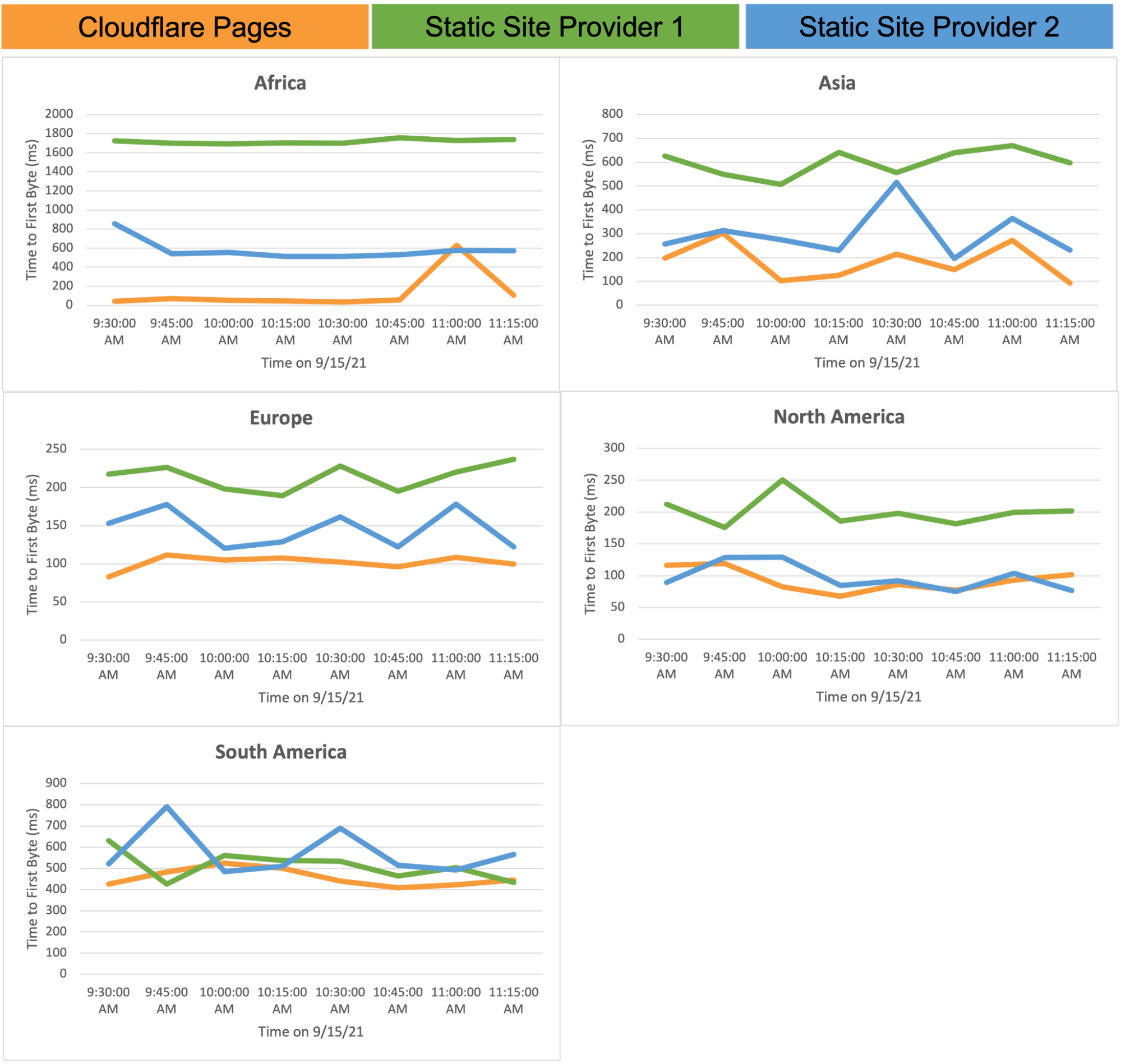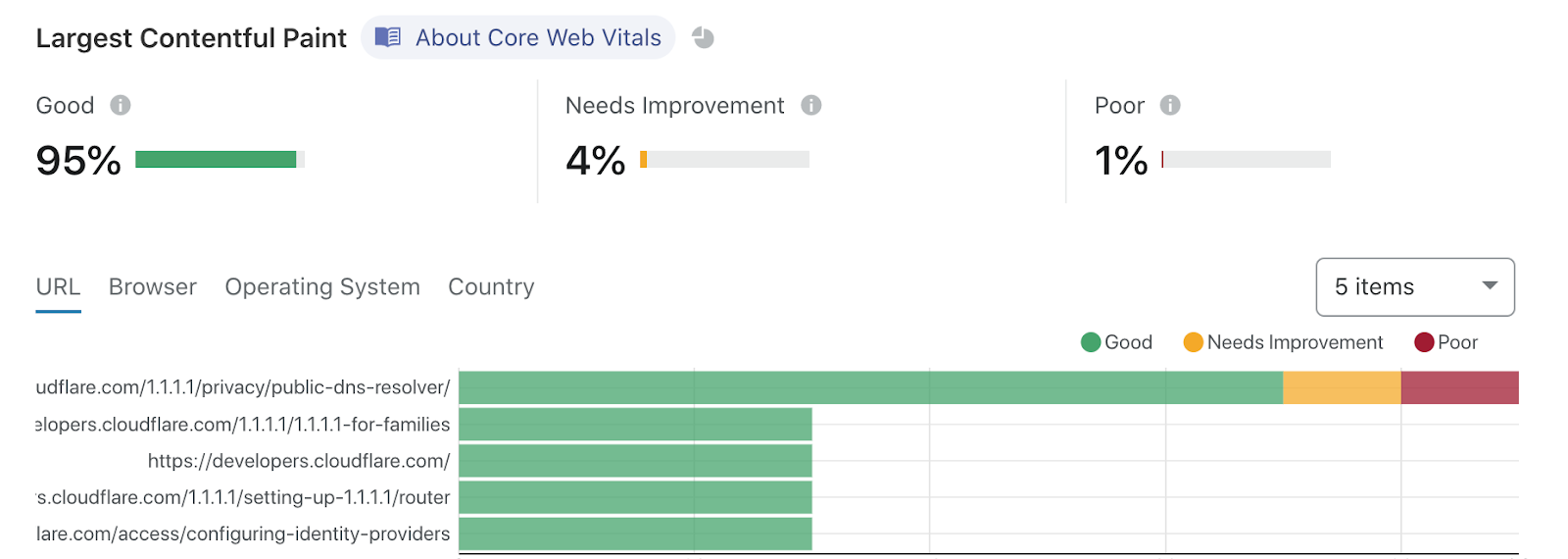
When we announced Cloudflare Pages in April, our goal wasn’t to bring just any web development tool to the table. As a front-end developer, it’s your responsibility to bring the ideas of your marketing, product and engineering teams to life by crafting a beautifully engaging experience for every customer. With all the hard work that goes into the development process — turning mock-ups to code, getting input from your team, staging and testing changes — you want the best performance possible for your site to showcase your work and optimize your customers’ experience.
Cloudflare Pages is the most secure and most scalable Jamstack platform to build and deploy your sites on the edge. But how is Pages so fast?
It comes down to three key reasons:
- Pages is built on one of the fastest networks in the world, putting us within 50 ms of 95% of the world’s Internet-connected population. Delivering Pages from this network is the basis of our speed.
- Cloudflare helps define and implement next generation standards, like QUIC + HTTP/3 and Early Hints, that push Pages performance to the next level.
- Pages has a killer developer experience that makes it easy to build the fastest websites on the planet.
Pages is delivered from one of the fastest networks in the world
After all the sweat, finger cramps, and facepalms you’ve managed to survive through development, the last thing you need is poor performance and load times for your site. This not only drives off frustrated customers, but if the site is a storefront, it can also have revenue implications.
We’ve got you covered! With Cloudflare’s extensive network, consisting of 250+ cities, your Pages site is deployed directly to the edge in seconds. With even more optimizations to our network routing, your customers are routed to the best data center, ensuring optimal loading and performance globally.
How does our performance compare?
Optimized routing, a giant CDN network, support for the latest standards, more performance enhancements — these all sound great! But let’s put them to the ultimate test: benchmarking. How do our Pages sites’ performance compare to those of our competitors?
The TTFB test
We deployed the same static site on Pages and on two other popular deployment platforms for comparison. We understand that benchmark tools like Google Lighthouse may introduce some geographic bias; performing a benchmarking analysis from San Francisco and hitting a local data center doesn’t tell us much about performance on a global scale. We wanted to create a simulation to run tests from different locations to give us a globally accurate representation. Using a tool called Catchpoint, we executed our test from 35 different cities around the world to measure the Time to First Byte (TTFB) for different providers. To give as accurate a reading as possible, we ran our test up to eight times, and averaged the result per city and per provider.
Around the world in 80ms
It’s common to see good performance in regions like the US and Europe, but at Cloudflare, we think even more globally. Cloudflare’s network allows you to reach a myriad of regions around the world without any additional effort or cost. Everytime our map grows, your global reach does too.
In our TTFB comparison, Cloudflare Pages is leading the race to your customers against two leading providers.

Pages gets early access to the latest, greatest, and fastest standards and network protocols
But it’s not just our network. We are proud of both driving and adopting the latest web standards. Our mission has always been to help build a better Internet, and collaborating on the latest standards is an essential part of that goal, especially when thinking about your Pages sites.
TLS 1.3: As the new encryption protocol, TLS 1.3 sets out to improve both speed and security for Internet users everywhere. With 1.3, during the course of that infamous “TLS handshake” you hear so much about, only one round trip, or back and forth communication, is required instead of two, thus shortening the process by milliseconds. A huge step forward for web security and performance, TLS 1.3 is available to all Pages users with no additional action required --- let the client and server handle it all.
IPv6: Today it’s extremely common for every person to have more than one Internet connected device, making the shift to IPv6 extremely crucial, now more than ever. Not only is IPv6 the answer to the “no more addresses” issue, but is also another added layer for performance and security with its ability to handle packets more efficiently, getting faster and faster as adoption of the standard increases.
QUIC & HTTP/3: The new internet transport protocol, QUIC & HTTP/3, team up to enable faster, reliable and more secure connections for your customers to web endpoints like your Pages site. QUIC, a transport layer protocol, aims to reduce connection and transport latency and avoid congestion and runs underneath HTTP/3. Enabled by default on every pages.dev domain, QUIC & HTTP/3 work in tandem to provide improved performance and security so long as the client complies.
With support for the latest standards like HTTP/3 and IPv6, as we work on support for dynamic frameworks, we will be able to offer response streaming, a feature other platforms don’t provide.
"Pages gives us more confidence than other providers, making it easier to migrate our app over and build new products that can easily scale with growing traffic." — David Simpson, COO at Designed.org
But we know that speed doesn’t just matter from a user perspective. It also matters from a developer perspective, too — and we’ve worked to make that just as great an experience.
A developer experience that we’d want to have
Generally speaking, performance of anything on the web is only as fast as the weakest link. A fast network, or support for the latest standards, doesn’t mean very much if we make it hard for a developer to do their job, or to optimize their code. So we knew the developer experience had to be a priority, too.
Fast for your users. Fast for you, too.
We set out to simplify every step of your developer experience by looking for ways to integrate into your existing publishing workflow. With Pages’ full git integration, grab your repo, tell us your framework and go! Collaborate with all members of your team — developers, PMs, marketers — quickly and efficiently with a protected preview URL per deployment to speed up the turnaround time for feedback. A simple Git commit and git push, and we’ll have your site up and running in seconds, and ready for you to share with your team or your customers.
Of course, even with lightning fast set-up and collaboration, we realize there’s more to the productivity of you and your team. From the time we launched Pages, we’ve been working on making our build times faster every day. Today, Pages builds are 3x faster than they were when we first launched the platform, but we’re not done yet. We’re aiming to have the fastest build times, so you can focus on what you do best — code, test, deploy, repeat — minus any wait.
Performance tuning, built in
In May of last year, Google announced a new program — Web Core Vitals — to provide unified guidance on how to measure the quality of a website, and to identify areas of improvement for developers, business owners, and marketers to deliver a better user experience. There are three key metrics as part of the program:
- Largest Contentful Paint: measures loading performance
- First Input Delay: measure interactivity
- Cumulative Layout Shift: measures visual stability
Fast-forward a year to 2021, Google officially announced that performance on these metrics will now be incorporated into Google Search results.
Performance is becoming an ever important aspect of the success of any site on the web.
We recognize this, and it’s part of why we’re so relentlessly focused on making sites hosted on Pages so fast. But you don’t need to just take our word for it. In addition to providing you with stellar performance across the globe, our Web Analytics tool is available to Pages customers with one click — so you can track your site’s Web Core Vitals and understand specific areas of improvement. As an example, here’s the Web Analytics on our very own Cloudflare Docs site.

We’re big believers in dogfooding — running our Docs site on Pages, and then using our Web Analytics to identify areas of improvement. It’s a big part of the Cloudflare ethos, and it’s how we can be confident in recommending our products to you.
What’s Next
With the increasing momentum behind the Jamstack movement, it’s a great time to be in the field. With Pages, you can rest easy knowing you’re taken care of every step of the way. We are so excited about the future of Cloudflare Pages --- integrating with Cloudflare Workers, supporting monorepos, enabling more sources of repo integration --- and how it brings a fresh perspective on how you build and deploy your sites on the web.
Check our docs to get started on Cloudflare Pages today!

